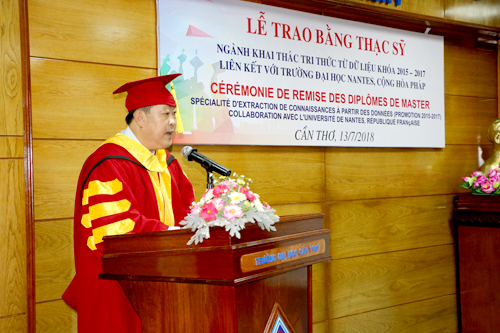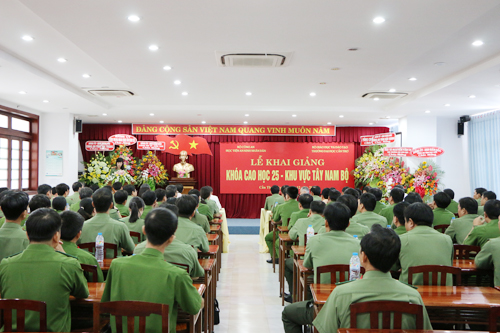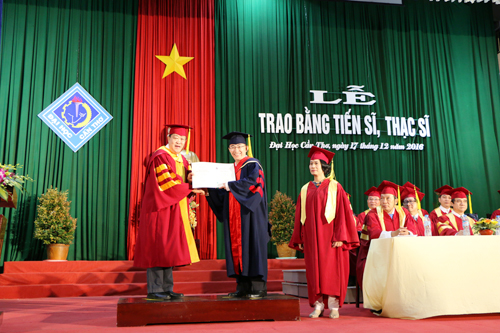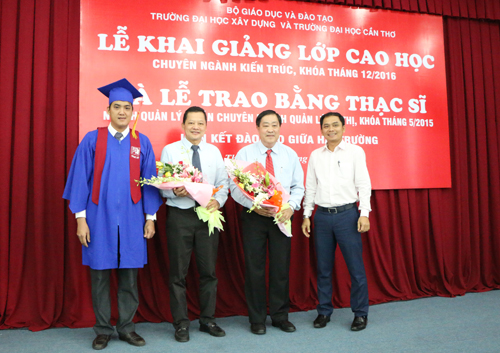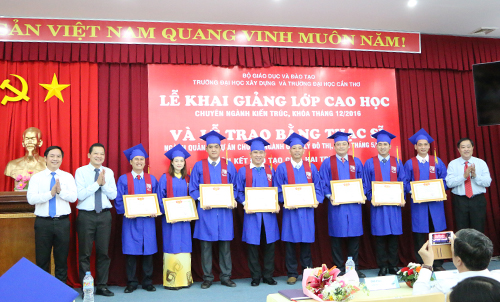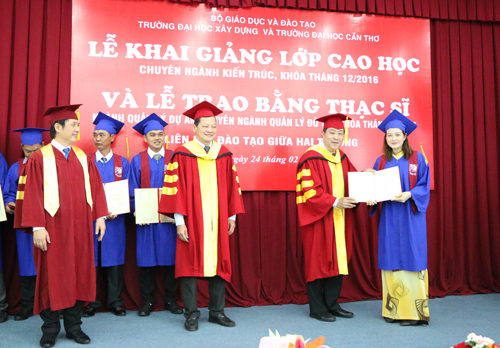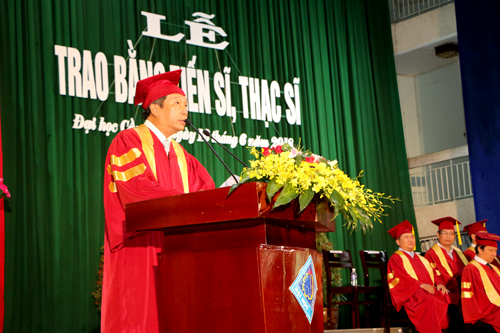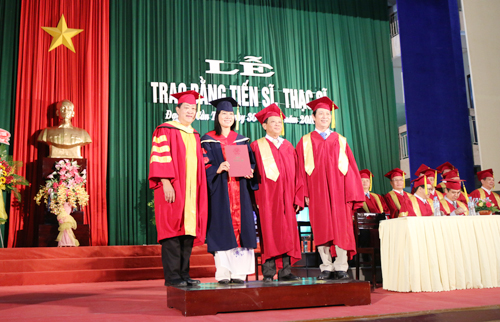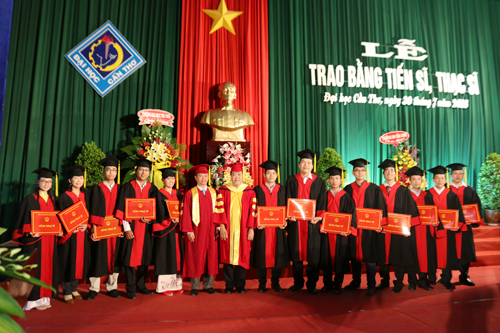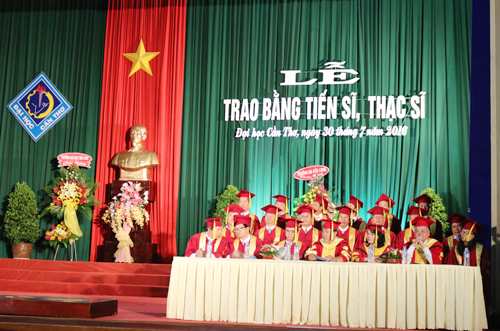
Tên đề tài: “Phân tích đa dạng sản xuất nông nghiệp đến thu nhập và an toàn lương thực nông hộ vùng Đồng bằng sông Cửu Long”.
Tác giả: Võ Văn Hà, Khóa: 2014
Chuyên ngành: Phát triển nông thôn; Mã số: 62620116. Nhóm ngành: Nông, lâm nghiệp và thuỷ sản.
Người hướng dẫn chính: TS. Vũ Anh Pháp - Trường Đại học Cần Thơ
Người hướng dẫn phụ: TS. Nguyễn Hồng Tín - Trường Đại học Cần Thơ
- Tóm tắt nội dung luận án
Đa dạng hóa trong sản xuất nông nghiệp là vấn đề đang được quan tâm hiện nay, đặc biệt trong bối cảnh mà sản xuất nông nghiệp chịu nhiều rủi ro và bị tác động tiêu cực của biến đổi khí hậu. Luận án nghiên cứu này nhằm mục tiêu tìm hiểu lược sử tiến trình chuyển dịch sản xuất, đánh giá hiệu quả đa dạng sản xuất đến thu nhập và an toàn lương thực nông hộ vùng ĐBSCL.
Luận án đã tiếp cận theo tiến trình nghiên cứu phát triển nông nghiệp và sử dụng khung lý thuyết về đa dạng trong sản xuất nông nghiệp đến đặc tính nông hộ và an toàn lương thực để phân tích; đồng thời áp dụng khung sinh kế để phân tích các nguồn vốn hộ nông dân theo vùng sinh thái và mô hình sản xuất. Nghiên cứu đã tổng hợp được nguồn số liệu thứ cấp, sơ cấp và phân tích số liệu phỏng vấn 309 nông hộ thực hiện các mô hình sản xuất ở các vùng sinh thái nông nghiệp khác nhau. Các số liệu được phân tích thống kê và sử dụng các kiểm định để đánh giá sự khác biệt. Các mô hình phân tích hồi qui đa biến đã tìm ra những yếu tố ảnh hưởng đến sự đa dạng sản xuất, chỉ số đa dạng thu nhập và mức độ an toàn lương thực nông hộ.
Kết quả cho thấy chuyển dịch đa dạng hóa sản xuất đã tác động đến tăng trưởng kinh tế vùng đồng bằng và đảm bảo an toàn lương thực quốc gia. Có sự cải cách từ hình thức sản xuất nông nghiệp theo hợp tác hóa để giải quyết tình trạng đói, cho đến đa dạng hóa sản xuất nông nghiệp phục phụ xuất khẩu, rồi dần chuyển sang sản xuất nông nghiệp thích nghi theo vùng sinh thái để thích ứng biến đổi khí hậu, và tương lai tiến đến nền sản xuất nông nghiệp ứng dụng công nghệ cao theo chuỗi giá trị sản phẩm. Sản xuất lúa được duy trì ổn định (khoảng 4 triệu ha) và chuyển dịch theo chuỗi giá trị để nâng cao chất lượng sản phẩm. Các cây hoa màu và cây công nghiệp ngắn ngày thay đổi đáp ứng các nhu cầu thị trường ở từng giai đoạn nhất định. Diện tích trồng cây lâu năm và vườn tăng lên theo sự chuyển dịch cơ cấu sản xuất. Đặc biệt, diện tích nuôi thủy sản tăng nhanh (gần 800 ngàn ha) theo lộ trình tái cơ cấu ngành nông nghiệp.
Thu nhập nông hộ nông dân tăng tương quan với sự đa dạng trong sản xuất nông nghiệp. Thu nhập hộ ở vùng nước ngọt (Ngập lũ cao là 196 triệu/hộ và Trung tâm là 123 triệu) cao hơn ở vùng nước mặn (119 triệu/hộ) là do chỉ số đa dạng thu nhập trong hộ cao hơn (tương ứng; 0,21 và 0,28 so với -0,18). Nhóm hộ đa dạng các mô hình sản xuất đều cho tổng thu nhập cao hơn nhóm hộ sản xuất lúa hàng hóa. Các yếu tố về hoạt động sản xuất trong nông nghiệp, phi nông nghiệp và ngoài nông trại có ảnh hưởng tăng thu nhập hộ.
Sự đa dạng hóa sản xuất cải thiện được các nội dung đảm bảo sự an toàn lương thực trong hộ gia đình. Cụ thể, 83% hộ khảo sát có diện tích đất dùng cho sản xuất lúa để đảm bảo an toàn lương thực nông hộ, và đa số nông hộ đang chuyển dịch các mô hình sản xuất để đáp ứng nhu cầu của thị trường và tăng khả năng tiếp cận các nguồn lương thực thông qua yếu tố tăng thu nhập hộ. Kết nghiên cứu cho biết sự an toàn lương thực trong hộ nông dân không chỉ quan tâm đến sản xuất nhiều lúa gạo, mà còn chú trọng yếu tố thu nhập và sự đa dạng trong sản xuất mới đảm bảo được an toàn lương thực.
Do đó, các giải pháp hỗ trợ kỹ thuật và sự linh hoạt của cơ chế chính sách rất cần thiết cho chuyển dịch đa dạng trong sản xuất nông nghiệp. Bên cạnh đó, nâng cao nguồn lực trong hộ là cách tiếp cận mới để tăng khả năng tiếp cận đến các nguồn lương thực, dinh dưỡng và chăm sóc sức khỏe gia đình tốt hơn.
- Những kết quả mới của luận án
- Ý nghĩa khoa học
Nghiên cứu này đóng góp đánh giá tác động đa dạng hóa sản xuất đến thu nhập và an toàn lương thực cấp hộ nông dân theo vùng sinh thái và mô hình sản xuất khu vực ĐBSCL. Đặc biệt, có cách tiếp cận mới theo tiến trình nghiên cứu nông nghiệp và phát triển nông thôn, đồng thời áp dụng khung lý thuyết “Sự chuyển dịch đa dạng sản xuất nông nghiệp có liên quan đến các đặc tính hộ ông dân và an toàn lương thực” để phân tích các nguồn vốn sinh kế hộ. Phân tích tình trạng mất an toàn lương thực không chỉ đủ hiểu biết về mặt thời gian xảy ra sự cố, mà còn cho biết mức độ ảnh hưởng của dinh dưỡng lương thực nói chung. Mức độ nghiêm trọng của tình trạng thiếu dinh dưỡng có liên quan đến mức độ lương thực bị thiếu hoặc mức độ tiêu thụ năng lượng trong chế độ ăn uống giảm xuống dưới ngưỡng đã được xác định; cụ thể là những người thiếu dinh dưỡng cũng được xem như bị thiếu lương thực.
- Ý nghĩa thực tiễn
Kết quả nghiên cứu có ý nghĩa thực tế là đa dạng hóa các hoạt động trong hộ nông dân hay mô hình sản xuất trên nền đất lúa làm tăng thu nhập so với sản xuất độc canh hay thâm cây lúa như hiện tại. Thực tiễn đã chứng minh rằng sản xuất ra nhiều lương thực (như lúa gạo vùng ĐBSCL) vẫn chưa thể đảm bảo các nội dung an toàn lương thực cấp độ hộ nông dân, mà yếu tố thu nhập mới có tác dụng tích cực đến việc cải thiện dinh dưỡng trong hộ, cũng như tăng cường khả năng tiếp cận các nguồn lương thực trong gia đình vùng nông thôn. Do vậy, kết quả nghiên cứu này có thể áp dụng vào các chương trình mục tiêu quốc gia về chuyển dịch trong nông nghiệp, phát triển nông thôn mới, giảm nghèo bền vững và bảo vệ môi trường sản xuất nông nghiệp khu vực ĐBSCL.
- Tính mới luận án
Đóng góp mới của nghiên cứu này là minh chứng được đa dạng hóa SX hay mô hình SXNN trên nền đất lúa làm tăng thu nhập hộ so với độc canh lúa hàng hóa. Nghiên cứu cũng cho biết tình trạng thu nhập thấp và không ổn định làm giảm khả năng tiếp cận đến các nguồn lương thực nông hộ. Đồng thời, tình trạng thiếu dinh dưỡng có liên quan đến lương thực bị thiếu hoặc mức độ tiêu thụ năng lượng trong chế độ ăn uống của người dân giảm xuống dưới ngưỡng được xác định.
- Các vấn đề cần tiếp tục nghiên cứu
Tiếp theo nghiên cứu này đề nghị tiếp tục thực hiện các nghiên cứu đánh giá đa dạng các hoạt động sản xuất nông nghiệp cho nhiều nhóm đối tượng khác nhau (giàu, trung bình, nghèo và nhóm dân tộc tiểu số) ở nhiều vùng sản xuất nông nghiệp. Từ đó, có bộ số liệu so sánh đánh giá toàn diện hơn về tác động đa dạng trong sản xuất nông nghiệp cho các vùng miền trên cả nước.
Đồng thời xem xét lại các quy hoạch sử dụng đất theo vùng và nâng cấp các hệ thống dịch vụ hỗ trợ theo khu vực đa dạng trong sản xuất nông nghiệp.
- Summary
Diversification in agricultural production is receiving attention at present, especially in the context where agricultural production is exposed to many risks and negative impacts of climate change. The research aims to understand the history of the production process, evaluate the effectiveness of product diversification to the income and food security of households in the Mekong Delta.
The thesis has approached according to the process of agricultural development research and uses the theoretical framework of agricultural production diversity to household characteristics and household food security for analysis; at the same time, applying the household livelihood framework in analyzing household capital sources by ecological region and cropping patterns. The research has collected secondary data sources, analyzed primary data sources and interview data from 309 households practicing cropping patterns in different ecological regions. The data were analyzed statistically and user testing methods to assess the different significance. The multivariate regression analysis models have identified factors that affect production diversity, income diversity index, and the level of household food security.
The results show that the diversification of production has affected the region's economic growth and ensured national food security. A reform from agricultural production under co-production had solved hunger, to agricultural production diversity for export, then gradually shifting to agricultural production to adapt to ecological regions and climate change, and the future towards high-tech agricultural production and product value chains. Rice production has been maintained stably (about 4 million hectares), but has been transformed along the value chain and improved product quality. Upland crops and annual industrial crops had changed to meet the market demand in each period. The area of land for perennial crops and orchards were increasing with the shift of production. In particular, the aquaculture area has increased rapidly (nearly 800 thousand hectares) following the restructuring process of agricultural production.
Household income increased in relation to the diversity of agricultural production. Total household income in freshwater areas (the high flooded area was 196 million VND and the central area was 123 million VND) was higher than in saline areas (119 million VND) due to the higher income diversity index of farm households. Factors of on-farm, non-farm and off-farm activities had an influence on increasing household income.
Diversified production has improved the contents of household food security. Specifically, 83% of surveyed households had farmland used for rice farming to ensure food security for households, and most farmers had been changing cropping patterns to meet market demand and increase the possibility of access to food resources through increasing household income. These results indicate that food security among farmers is not only concerned with producing a lot of rice, but also income and diversity of agricultural production to ensure food security.
Therefore, technical assistance solutions and the flexibility of policy mechanisms are essential for the diversification of agricultural production. In addition, improving household resources is a new approach to increase access to better sources of food, nutrition and better care for family members.
- New contributions to the dissertation
- Scientific significance
This study contributes to assessing the impact of product diversification on household income and food security by agro-ecological regions and cropping patterns in the Mekong Delta. In particular, there is a new approach according to the research process of agriculture and rural development; at the same time, applying the theoretical framework "The diversification in agricultural production is related to characteristics of farmer households and food security" to analyze the household livelihoods resources. Analysis of food insecurity is not only understood the time of the incident, but also the extent of the impact of food nutrition in general. The severity of malnutrition is related to the level of food shortage or the level of energy consumption in the diet falls below the defined threshold; In particular, people who are undernourished are also considered to be lack food.
- Practical significance
The research results are significant in the fact that diversification of production in farmer households or farming systems on rice land increased income compared to current monoculture rice or intensive rice farming. The fact has been proved that the production of a lot of cereal food (such as rice in the Mekong Delta) cannot ensure food security at the household level, but the income factor has the effect of improving nutrition, as well as enhancing the ability to access food resources at farmer household in rural areas. Therefore, the results from this study can be applied to national target programs on transformation in agriculture, development of new rural areas, sustainable poverty reduction and environmental protection in agricultural production in the Mekong Delta region.
- Novelty thesis
The new contribution of this study was to demonstrate that the diversification of agricultural production or the cropping patterns based on rice farmland increased household income compared to households with a monoculture of commodity rice production. The study also showed that low and unstable incomes reduced access to food sources of households. At the same time, nutritional deficiencies were related to food deficiencies or the level of energy consumption in people's diets falling below defined thresholds.
- Further research
Following the results of this study, it is recommended to continue studying and assessing the impacts of diversified agricultural production for various target groups (rich, medium, poor and ethnic minorities) in different of agricultural production regions. Thereby, there will be a lot of data in evaluating agricultural production transition in regions across the country.
At the same time, review the land use plans by agriculture region and upgrade production support services for each agricultural production area.
- Xem chi tiết nội dung luận án
- Xem thông tin đăng tải tại Website Bộ giáo dục và Đào tạo. (Nhập tên NCS vào ô tìm kiếm)





